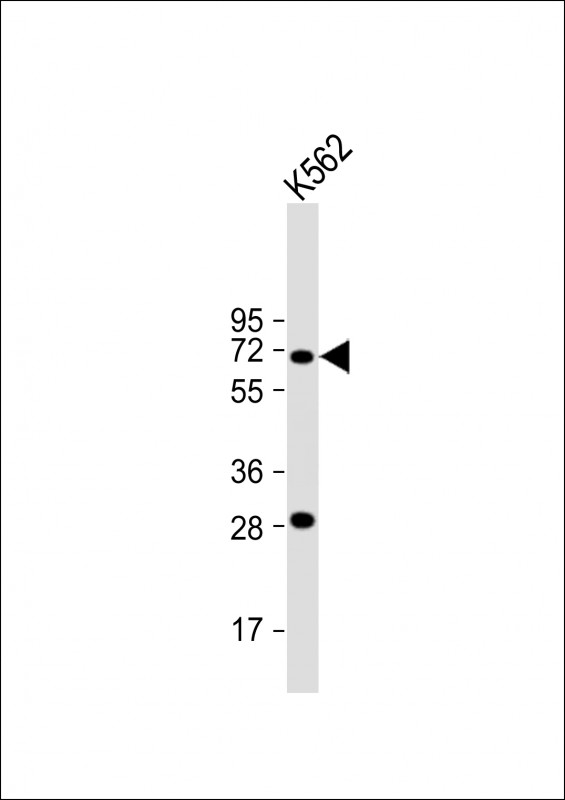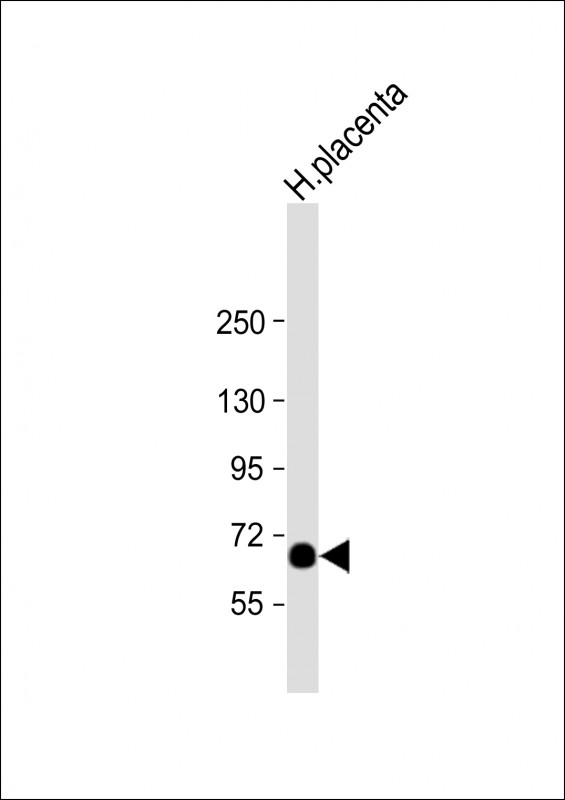STT3A Antibody (Center)
Purified Rabbit Polyclonal Antibody (Pab)
- 产品详情
- 实验流程
- 背景知识
Application
| WB, E |
|---|---|
| Primary Accession | P46977 |
| Other Accession | Q2KJI2, P46978, Q5RCE2 |
| Reactivity | Human, Mouse |
| Predicted | Bovine, Mouse |
| Host | Rabbit |
| Clonality | polyclonal |
| Isotype | Rabbit IgG |
| Calculated MW | 80530 Da |
| Gene ID | 3703 |
|---|---|
| Other Names | Dolichyl-diphosphooligosaccharide--protein glycosyltransferase subunit STT3A, Oligosaccharyl transferase subunit STT3A, STT3-A, 2.4.99.18, B5, Integral membrane protein 1, Transmembrane protein TMC, STT3A, ITM1, TMC |
| Target/Specificity | This STT3A antibody is generated from a rabbit immunized with a KLH conjugated synthetic peptide between 476-507 amino acids from the Central region of human STT3A. |
| Dilution | WB~~1:2000 E~~Use at an assay dependent concentration. |
| Format | Purified polyclonal antibody supplied in PBS with 0.09% (W/V) sodium azide. This antibody is purified through a protein A column, followed by peptide affinity purification. |
| Storage | Maintain refrigerated at 2-8°C for up to 2 weeks. For long term storage store at -20°C in small aliquots to prevent freeze-thaw cycles. |
| Precautions | STT3A Antibody (Center) is for research use only and not for use in diagnostic or therapeutic procedures. |
| Name | STT3A {ECO:0000303|PubMed:31296534, ECO:0000312|HGNC:HGNC:6172} |
|---|---|
| Function | Catalytic subunit of the oligosaccharyl transferase (OST) complex that catalyzes the initial transfer of a defined glycan (Glc(3)Man(9)GlcNAc(2) in eukaryotes) from the lipid carrier dolichol- pyrophosphate to an asparagine residue within an Asn-X-Ser/Thr consensus motif in nascent polypeptide chains, the first step in protein N-glycosylation (PubMed:19167329, PubMed:31296534, PubMed:31831667, PubMed:34653363, PubMed:38670073, PubMed:39509507). N- glycosylation occurs cotranslationally and the complex associates with the Sec61 complex at the channel-forming translocon complex that mediates protein translocation across the endoplasmic reticulum (ER) (PubMed:19167329, PubMed:31296534, PubMed:31831667, PubMed:34653363, PubMed:38670073, PubMed:39509507). All subunits are required for a maximal enzyme activity (PubMed:19167329, PubMed:31831667, PubMed:34653363). This subunit contains the active site and the acceptor peptide and donor lipid-linked oligosaccharide (LLO) binding pockets (PubMed:19167329). STT3A is present in the majority of OST complexes and mediates cotranslational N-glycosylation of most sites on target proteins, while STT3B-containing complexes are required for efficient post-translational glycosylation and mediate glycosylation of sites that have been skipped by STT3A (PubMed:19167329, PubMed:38670073, PubMed:39509507). STT3A-containing OST-A complex is also required to prevent hyperglycosylation of some target proteins by preventing glycosylation of facultative sites before folding of target proteins is completed (PubMed:39509507). |
| Cellular Location | Endoplasmic reticulum. Endoplasmic reticulum membrane {ECO:0000250|UniProtKB:P46978}; Multi-pass membrane protein {ECO:0000250|UniProtKB:P46978} |
| Tissue Location | Expressed at high levels in placenta, liver, muscle and pancreas, and at very low levels in brain, lung and kidney Expressed in skin fibroblasts (at protein level) |
For Research Use Only. Not For Use In Diagnostic Procedures.
Provided below are standard protocols that you may find useful for product applications.
BACKGROUND
Catalytic subunit of the N-oligosaccharyl transferase (OST) complex which catalyzes the transfer of a high mannose oligosaccharide from a lipid-linked oligosaccharide donor to an asparagine residue within an Asn-X-Ser/Thr consensus motif in nascent polypeptide chains. N-glycosylation occurs cotranslationally and the complex associates with the Sec61 complex at the channel-forming translocon complex that mediates protein translocation across the endoplasmic reticulum (ER). SST3A seems to be involved in complex substrate specificity. STT3A is present in the majority of OST complexes and mediates cotranslational N-glycosylation of most sites on target proteins, while STT3B-containing complexes are required for efficient cotranslational glycosylation and mediate glycosylation of sites that have been skipped by STT3A.
REFERENCES
Hong G.,et al.Genomics 31:295-300(1996).
Lissy N.A.,et al.Biochim. Biophys. Acta 1306:137-141(1996).
Ota T.,et al.Nat. Genet. 36:40-45(2004).
Kalnine N.,et al.Submitted (MAY-2003) to the EMBL/GenBank/DDBJ databases.
Taylor T.D.,et al.Nature 440:497-500(2006).
终于等到您。ABCEPTA(百远生物)抗体产品。
点击下方“我要评价 ”按钮提交您的反馈信息,您的反馈和评价是我们最宝贵的财富之一,
我们将在1-3个工作日内处理您的反馈信息。
如有疑问,联系:0512-88856768 tech-china@abcepta.com.























 癌症的基本特征包括细胞增殖、血管生成、迁移、凋亡逃避机制和细胞永生等。找到癌症发生过程中这些通路的关键标记物和对应的抗体用于检测至关重要。
癌症的基本特征包括细胞增殖、血管生成、迁移、凋亡逃避机制和细胞永生等。找到癌症发生过程中这些通路的关键标记物和对应的抗体用于检测至关重要。 为您推荐一个泛素化位点预测神器——泛素化分析工具,可以为您的蛋白的泛素化位点作出预测和评分。
为您推荐一个泛素化位点预测神器——泛素化分析工具,可以为您的蛋白的泛素化位点作出预测和评分。 细胞自噬受体图形绘图工具为你的蛋白的细胞受体结合位点作出预测和评分,识别结合到自噬通路中的蛋白是非常重要的,便于让我们理解自噬在正常生理、病理过程中的作用,如发育、细胞分化、神经退化性疾病、压力条件下、感染和癌症。
细胞自噬受体图形绘图工具为你的蛋白的细胞受体结合位点作出预测和评分,识别结合到自噬通路中的蛋白是非常重要的,便于让我们理解自噬在正常生理、病理过程中的作用,如发育、细胞分化、神经退化性疾病、压力条件下、感染和癌症。







